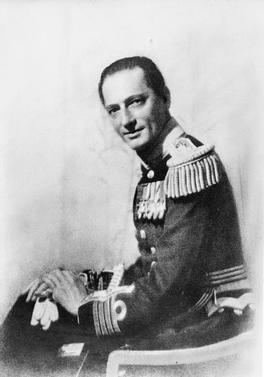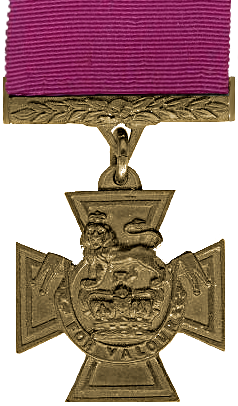
Kronstadt is a Russian port city in Kronshtadtsky District of the federal city of Saint Petersburg, located on Kotlin Island, 30 km (19 mi) west of Saint Petersburg, near the head of the Gulf of Finland. It is linked to the former Russian capital by a combination levee-causeway-seagate, the St Petersburg Dam, part of the city's flood defences, which also acts as road access to Kotlin island from the mainland.

Augustus Willington Shelton Agar, was a Royal Navy officer in both the First and the Second World Wars. He was a recipient of the Victoria Cross, the highest award for gallantry in the face of the enemy that can be awarded to British and Commonwealth forces, for sinking a Soviet cruiser during the Russian Civil War.
Captain Gordon Charles Steele VC was an English Naval officer and a recipient of the Victoria Cross, the highest and most prestigious award for gallantry in the face of the enemy that can be awarded to British and Commonwealth forces.

Rear-Admiral Claude Congreve Dobson VC, DSO was an English recipient of the Victoria Cross, the highest and most prestigious award for gallantry in the face of the enemy that can be awarded to British and Commonwealth forces.

HM Coastal Motor Boat 4 is the torpedo boat used when Lieutenant Augustus Agar earned a Victoria Cross for carrying out a raid on Soviet warships in Kronstadt and sinking the cruiser Oleg.

Admiral Sir Walter Henry Cowan, 1st Baronet,, known as Tich Cowan, was a Royal Navy officer who saw service in both the First and Second World Wars; in the latter he was one of the oldest British servicemen on active duty.

HMS Vindictive was a warship built during the First World War for the Royal Navy (RN). Originally designed as a Hawkins-class heavy cruiser and laid down under the name Cavendish, she was converted into an aircraft carrier while still being built. Renamed in 1918, she was completed a few weeks before the end of the war and saw no active service with the Grand Fleet. The following year she participated in the British campaign in the Baltic against the Bolsheviks, during which her aircraft made numerous attacks against the naval base at Kronstadt. Vindictive returned home at the end of the year and was placed in reserve for several years before her flight decks were removed and she was reconverted back into a cruiser. The ship retained her aircraft hangar and conducted trials with an aircraft catapult before she was sent to the China Station in 1926. A year after her return in 1928, she was again placed in reserve.

The Baltic Sea campaigns were conducted by Axis and Allied naval forces in the Baltic Sea, the Gulf of Bothnia, the Gulf of Finland and the connected lakes Ladoga and Onega on the Eastern Front of World War II. After early fighting between Polish and German forces, the main combatants were the Kriegsmarine and the Soviet Navy, with Finland supporting the Germans until 1944 and the Soviets thereafter. The Swedish Navy and merchant fleet played important roles, and the British Royal Navy planned Operation Catherine for control of the Baltic Sea and its exit choke point into the North Sea.

Petropavlovsk was the third of the four Gangut-class dreadnoughts built before World War I for the Imperial Russian Navy, the first Russian class of dreadnoughts. She was named after the Russian victory in the siege of Petropavlovsk during the Crimean War. The ship was completed during the winter of 1914–1915, but was not ready for combat until mid-1915. Her role was to defend the mouth of the Gulf of Finland against the Germans, who never tried to enter, so she spent her time training and providing cover for minelaying operations. Her crew joined the general mutiny of the Baltic Fleet after the February Revolution of 1917 and she was the only dreadnought available to the Bolsheviks for several years after the October Revolution of 1917. She bombarded the mutinous garrison of Fort Krasnaya Gorka and supported Bolshevik light forces operating against British ships supporting the White Russians in the Gulf of Finland in 1918–1919. Later, her crew joined the Kronstadt rebellion of 1921 and she was renamed Marat after the rebellion was crushed.

The Andrei Pervozvanny class were a pair of pre-dreadnought battleships built in the first decade of the twentieth century for the Baltic Fleet of the Imperial Russian Navy. They were conceived by the Naval Technical Committee in 1903 as an incremental development of the Borodino-class battleships with increased displacement and heavier secondary armament. The disastrous experiences of the Russo-Japanese War of 1904–1905 and the unrest resulting from the 1905 Russian Revolution led to countless redesigns, change orders and delays in construction. Despite the designers' repeated attempts to modernize the ships while under construction, they were obsolete in concept from the beginning, and even more so when they entered service in 1911.

The British campaign in the Baltic 1918–1919 was a part of the Allied intervention in the Russian Civil War. The codename of the Royal Navy campaign was Operation Red Trek. The intervention played a key role in enabling the establishment of the independent states of Estonia and Latvia. It failed to secure the control of Petrograd by White Russian forces, which was one of the main goals of the campaign.

Pamiat Azova was a unique armoured cruiser built for the Imperial Russian Navy in the late 1880s. She was decommissioned from front line service in 1909, converted into a depot ship and sunk by British torpedo boats during the Baltic Naval War, part of the Russian Civil War.

Coastal Motor Boat was a small high-speed British torpedo boat used by the Royal Navy in the First World War and up to end of the Second World War.

Andrei Pervozvanny was an Andrei Pervozvanny-class predreadnought battleship built for the Imperial Russian Navy during the early-1900s. The ship's construction was greatly delayed by design changes as a result of the Russo-Japanese War and labor unrest after the 1905 Revolution, and she took nearly six years to build. Andrei Pervozvanny was not very active during World War I and her bored sailors joined the general mutiny of the Baltic Fleet in early 1917. She was used by the Bolsheviks to bombard the rebellious garrison of Fort Krasnaya Gorka in 1919 during the Russian Civil War and was torpedoed by British Coastal Motor Boats shortly afterwards, as part of the Allied intervention in the Russian Civil War. The ship was never fully repaired and was scrapped in 1923.
Men of the Sea also known as Baltic Sailors is a 1938 Soviet war film directed by Aleksandr Faintsimmer. The film is about the Bolshevik Kronstadt sailors' 1919 defense of Petrograd from the White Army during the Russian Civil War.
Flight Lieutenant Arthur Clunie Randall was a Scottish World War I flying ace credited with 10 aerial victories. After earning a Distinguished Flying Cross during the war, he remained in military service until 1926.

Captain Russell Hamilton McBean DSO DSC was an officer in the Royal Navy and was one of the men who took part in the Raid on Kronstadt in August 1919.

Gavriil was an Orfey-class destroyer of the Russian Imperial Navy. The destroyer was built by the Russo-Baltic Yard at Reval, launching on 5 January 1915 and completing in October 1916. She served with the Baltic Fleet during the remainder of the First World War, and after the October Revolution joined the Bolshevik Red Fleet. She was active during the Russian Civil War, taking part in several engagements against British ships during the British campaign in the Baltic, and was sunk by a mine on 21 October 1919.
HMS Spenser was a Thornycroft type flotilla leader of the British Royal Navy. She was built by J I Thornycroft from 1916 to 1917 as the lead ship of her class, launching in September 1917 and completing in December that year.

Azard was one of eight Orfey-class destroyers built for the Russian Imperial Navy during World War I. Completed in 1916, she served with the Baltic Fleet and joined the Bolshevik Red Fleet after the October Revolution of 1918. She was active during the Russian Civil War, taking part in several engagements against British ships during the British campaign in the Baltic. The destroyer was renamed Zinoviev in 1922 and Artem in 1928. She remained in service with the Soviet Baltic Fleet when Germany invaded the Soviet Union in 1941, and was sunk by a mine on 28 August.




















